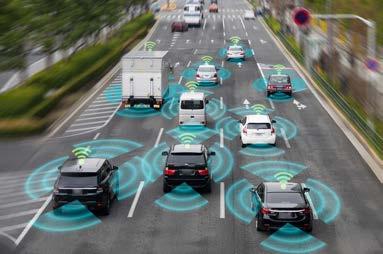
23 minute read
ADVANCE GUARD
AS PRIVATE CYBERSECURITY ORGANISATIONS’ ROLES IN POLICING THE CYBER SPACE GROW, IS THERE A NEED FOR INCREASED REGULATORY CONTROL FOR THIS SECTOR? DANIEL BARDSLEY INVESTIGATES.
Afew decades ago, researchers talked of a “quiet revolution” brought about by the growth of the private security industry.
Where once only the police held sway, in the brave new world of the 1970s and 1980s, a parallel private security sector developed.
Nightclubs, industrial facilities and other premises were being guarded by private operators who would sometimes use physical force against those who they felt had breached the rules.
While the quiet revolution term originated in North America, a similar phenomenon was seen in many other regions.
In response, governments and local authorities began regulating the private security sector, keen to ensure that it operated within reasonable parameters.
Now, a researcher has described the development of the private cybersecurity industry as being a “second quiet revolution” and has asked if regulations are needed to govern it too.
In a paper published this year in the Journal of Contemporary Criminal Justice, Professor Mark Button, of the University of Portsmouth in the United Kingdom, notes that this sector is fast eclipsing the physical private security industry in revenue and scale.
Button, whose paper is entitled, The “New” Private Security Industry, the Private Policing of Cyberspace and the
Jonathan Couch, ThreatQuotient
Regulatory Questions, suggests that there has been little debate among researchers about the implications of the sector’s growth or of the policies needed to govern the new landscape.
“Most of the issues, the questions that arise with physical security, also arise in the cyber world. There are some areas where I would be very surprised if there isn’t need for some kind of regulation,” says Button.
“The issue off competence in the physical world, that’s been a major problem – of cowboy operators. Is that the same in the cybersecurity world? Are companies offering services they’re not capable of [delivering]?
“By making private cybersecurity providers stronger by some kind of control, would that be an opportunity to further enhance organisations purchasing their services because their performance would be so much higher?”
The paucity of official action against cybercrime is shown by the fact that there are just a few dozen prosecutions annually in, for example, the United Kingdom for crimes linked to hacking, viruses, ransomware and distributed denial of service (DDoS) attacks.
“The police do have good people, but the numbers that you would need to supply that to the large number of organisations and individuals who have been attacked is not enough,” says Button.
Although governments have set up organisations to focus specifically on cybersecurity, it is largely private companies that try to keep a lid on cybercrime through actions that are as much preventative as reactive. Potential worries over these companies’ actions are largely focused on privacy and the use of sensitive data.
“Imagine if you’re doing work for a large organisation with large access to personal information of individuals. It’s incredibly important that that information is protected,” says Button.
The private cybersecurity sector may also wield, Button notes, cyber tools that can be used for harmful activities such as cyber-espionage. The sector carries out functions that private citizens would not undertake, something that Button suggests may indicate a need for regulation.
Another issue highlighted by Button concerns companies that offer datarelated services. Their use can result in customers being branded – often unfairly – as fraudsters when transactions are analysed. While some nations have tough data-processing rules, Button says that these do not cover many activities of the new security sector.
Although parallels can be drawn between the private physical security industry and the private cybersecurity sector, Button points out clear differences.
Barriers to entry in terms of skills are typically higher in cybersecurity, which may keep out some of the unsavoury element sometimes associated with physical security.
Also, although ethical hackers might sometimes be recruited into penetration testing roles, Button notes that there have been few scandals sparked by criminal involvement in private cybersecurity.
Nonetheless, he raises the question of whether penetration testers, security architects, chief information security officers (CISOs) and internet moderators (who may have access to illegal material and other information that should not be in the public domain) should be licensed.
Professor Eerke Boiten, director of the Cyber Technology Institute at De Montfort University, Leicester in the United Kingdom, says that it is unclear to him whether licensing is needed. He suggests that companies are able to assess the worth of cybersecurity services that they are buying.
“When you hire a company, you interview them and check their qualifications, and there are plenty of qualifications in the cybersecurity sector. I’m not convinced that we have a surplus of bad people in the sector,” he says.
While the likes of CISOs could use their position to cause a great deal of damage, Boiten says that the same could be said of people in many other senior corporate roles.
According to Jonathan Couch, ThreatQuotient’s senior vice president, strategy, regulations and licensing requirements could lead to box-ticking. He suggests that this has happened with the emphasis on governance, risk and compliance (GRC) in organisations.
“It would be like GRC – it gets so regulated, you have compliance and not security. [If] you have a CISO who has a tonne of credentials … it doesn’t mean they’re any better at their job,” he says.
Also, Couch suggests that more regulation could hamper the activity of a
“The certifications that have been developed even by industry don’t necessarily mean that you’re any better or you know any more than anyone else,” he says.
Regulations over the use of data, such as the EU’s General Data Protection Regulation (GDPR), mean that additional requirements such as licensing may be unnecessary, according to Professor Siraj Shaikh, a professor of systems security at Coventry University in the United Kingdom. Specific sectors, such as finance, have their own regulations.
“I don’t think an introduction of another level of regulation would happen,” he says.
He does, however, suggest that licensing could be used to promote training or continuous professional development (CPD, also sometimes written as continuing professional development), which is a requirement in
Professor Siraj Shaikh, Coventry University
cybersecurity sector that is battling fastmoving attackers.
Militaries have to go through what American strategists have called the OODA loop – observe, orient, decide and act – faster than their adversaries. Similarly, effective cybersecurity requires organisations to complete these actions at a brisk pace.
“I wouldn’t support regulation that may slow down our ability or impede our ability to be more agile,” he says.
Couch is also sceptical about the value of the numerous certifications available in the cybersecurity sector, saying that he has tended to let his own lapse. some other professions, such as medicine, where practitioners are licensed.
“In cybersecurity, one of the elements is to keep abreast of threats. It’s a very dynamic area and it will remain this way,” says Shaikh.
While some experts are doubtful about the need for licensing, Button says that he is not so much calling for more regulation but is primarily focused on sparking debate about what rules could or should be introduced. In his paper, he says there is “a regulatory gap” when it comes to the new private security sector and in his view, more research is needed to fill this void.
HOW TO ENSURE SECURITY WHILE WORKING REMOTELY
MARCUS WHITTINGTON, CO-FOUNDER AND COO, SENTRYBAY AND ABHIJIT MAHADIK, DIRECTOR – CYBERSECURITY SOLUTIONS, RAQMIYAT, DISCUSS THE RISKS OF ENABLING REMOTE ACCESS FROM UNMANAGED DEVICES AND HOW SENTRYBAY’S SOLUTIONS CAN HELP ENTERPRISES STAY SECURE.
With the outbreak of COVID-19, there are widespread extended requirements for staff to work from home. The phrase “work-from-home” brings-in fears on data security and data-pilferage risks from unmanaged end-user owned remote desktops, PCs and laptops that would be used as endpoints by staff and external vendors, partners and contractors.
Remote access from unmanaged devices introduces elevated risks. Often these devices have a lower security posture, possibly out-of-date anti-virus
Abhijit Mahadik, Raqmiyat
or internet security software; they offer a higher risk of compromise because they might be running counterfeit or unlicensed solutions, or they are on untrusted networks. The enterprises have little or no control over what software is running or has previously been executed on the devices.
These unmanaged devices pose a higher risk of sensitive data being stolen (including corporate credentials) from attacks involving keylogging, which along with spyware is ranked the highest global malware, according to the NTT Security Threat Intelligence report. Other attacks to be wary of include screen-capture, screengrabbing, man-in-the-browser, saved account detail harvesting, screenmirroring, man-in-the-middle, DLL injection and RDP double-hop. During the coronavirus crisis, the risk is exponentially much higher.
VPN is the commonly utilised form of connectivity to ensure that remote devices can connect to corporate
Abhijit Mahadik, Raqmiyat


Marcus Whittington, Sentrybay
networks. However, VPN does not protect the user from malware that records the keystrokes entered or takes pictures or videos of the user’s endpoint in order to steal data. They scrape up passwords, credit card and banking information, personal details, and more, to use in identity theft and other malicious deeds. Every piece of data entered into applications such as Word, Excel, Outlook, other Office apps, corporate apps, browser, webmail and SaaS applications by the home-based employee, contractor or supplier such as, can be lifted from the endpoint itself by malware. This can then be sent out to the command and control server of the cybercriminal. In summary, all this data can be stolen by cybercriminals even before it enters the VPN tunnel.
Ideally, with virtually no time for preparation, customers should look for products that can be deployed quickly (i.e. within 24 hours) and which do not involve specially configured software or hardware – a simple download and install from pre-configured software is the preferred option. This means selecting proven anti-keylogging software that can protect every keystroke into any application and prevent screen-scraping malware from stealing credentials and sensitive corporate data.
Raqmiyat, an authorised reseller of Sentrybay, provides secured workfrom-home solutions. “During this challenging time, organisations struggle to provide a secured workfrom-home solution. By partnering with Sentrybay, we are offering this secured solution to help our customers without sacrificing their security posture,” says Abhijit Mahadik, director – Cybersecurity Solutions, Raqmiyat.
Unlike other cybersecurity vendors who only worry about cleaning and protecting endpoints, SentryBay cares about data security and uses patented technology of anti-keyloggers and antiscreen captures to achieve this.
Armoured Browser from SentryBay provides a browser on Mac & Windows, which offers a very unique secured browser that provides anti-key logging, anti-screen capture and anti-screen scrap features, thus, enabling a secured browsing environment for sensitive work to be done irrespective these malwares on the PCs.
The best part of this offering is that it creates separate user and desktop sessions and leaves no-trace upon closing. With the latest enhancements, it can be installed as a pseudo-remote access solution to lock down use of, say, Office365, SaaS apps, web browsing and more. It can also be deployed for Citrix, Vmware or any other remote access solution deployed.
“We have experienced a huge surge in demand worldwide, especially in the UAE for this niche solution from Sentrybay. Some of our largest banking clients have added licenses in the past week, specifically to enable more employees to work from home,” says Marcus Whittington, co-founder and COO, Sentrybay.
CYBERSECURITY TRENDS FOR 2020
AMIR KANAAN, MANAGING DIRECTOR, MIDDLE EAST, TURKEY & AFRICA, KASPERSKY, SHARES INSIGHTS INTO THE LATEST TRENDS THAT WILL IMPACT THE EVER-EVOLVING CYBERSECURITY SPACE.

The year 2019 was another busy one for the cybersecurity industry. Worldwide spending on security solutions is expected to achieve a growth rate of 9.2 percent over the 2018-2022 forecast period and total $133.8 billion in 2022. The average cost of an attack, meanwhile, ranged from $108,000 for an SME to $1.4 million for a large enterprise.
We can be certain that the year 2020 will be another hectic one for cybersecurity professionals. As ever, cybercriminals will modify their strategies, particularly as more and more organisations migrate to the public cloud and 5G networks finally begin to come online.
As we do every year, Kaspersky has delved into its collective knowledge base to identify key cybersecurity trends for the year ahead.
Confusion in the cloud ICT departments are transitioning rapidly from on-premise models to assets deployed in the public cloud. As this migration takes place, there is a possibility that gaps may appear
in corporate cybersecurity strategies. Organisations embracing the public cloud as they transform their ICT infrastructure should understand that they will retain at least partial responsibility for security of their data even after it has been migrated. It is up to both providers and users to keep cloudlocated data safe and responsibilities must be clearly defined in contracts between providers and customers. While agreements should be read closely, customers should assume that they are responsible for protecting the operating systems, applications and data that they themselves deploy in the cloud.
Continued attacks via IoT devices There will be 75 billion connected, Internet of Things (IoT) devices around the world by 2025, according to Statista. While consumers love their smart TVs and connected baby monitors, IoT devices are typically perceived as being vulnerable to hacks, particularly on the default settings that home users usually forget to change when setting up devices. A hacked IoT device can represent a major vulnerability. As well as being used to spy on individuals, it could also become part of a botnet and used to carry out DDoS attacks, like the notorious Mirai botnet that brought down several online services in 2016. Hackers will keep on targeting IoT devices, so users must make sure to follow basic rules on how to keep them secure.
Phishing via messaging Far from being immune to attacks, smartphones have become one of the leading platforms for cybersecurity breaches. According to the RSA, more than 60 percent of online fraud originates from mobile devices and 80 percent of mobile fraud comes from mobile apps, rather than mobile browsers.
As consumers now do so much of their business on their phones, a phone is a potential goldmine of both personal and corporate information. Hackers will continue to focus considerable effort on phishing, spear phishing and malware attacks targeted at smartphones. Users will need to be much more aware of the threat and how to deal with it.
Artificial intelligence: a doubleedged sword Artificial intelligence is a double-edged sword for the cybersecurity industry. On the one hand, organisations are using it to identify and prevent attacks. On the other hand, cybercriminals can use AI to make their attacks more ‘intelligent’ and thus able to avoid detection.
Artificial intelligence could also help hackers make their social engineering strategies more effective. This popular hacking technique effectively involves tricking individuals to divulge information that can compromise personal or corporate security. AI could be used to trawl for sensitive information on individuals and organisations, as well as being used to create content that can pass through typical cybersecurity filters, such as e-mail messages that look like they were written by humans.
5G networks will come under attack The year 2020 will see 5G networks
start to finally come online. The boost it will provide to connectivity speeds will be significant and there will be even more data moving across networks than ever before. This will give a boost to the Internet of Things and it will allow companies to capture more data than ever before, supporting Big Data and AI strategies. There will, however, be significant risk as hackers target networks in an effort to retrieve data related to health, safety & the environment (HSE), personal health and corporate performance. A recent European Union report identifies potential key threats to 5G networks, particularly their increasing reliance on software. Any flaws in the applications used to manage networks could enable malicious actors to insert backdoors and begin to siphon off data.
Multi-factor authentication becomes prevalent The password remains the most common method of protecting sensitive data, but it is now just a first of line of defence. While two and three-factor authentication is not a new concept, uptake has been slow, with just 20 percent of Office 365 subscribers using it as of the middle of 2018. Expect to see a much more rapid uptake of one-time passwords and biometrics over the next year as companies embrace the principle of multi-factor authentication (MFA). While MFA is often seen as cumbersome by users, it has benefits beyond offering more secure access to a particular application. It also counters the phenomena known as ‘credential stuffing’, where users tend to use the same password across several accounts. Gaining access to that one password by infiltrating a poorly secured service can open up access to all or many of a person’s other accounts. MFA helps avoid this.
WHAT THE CORONAVIRUS OUTBREAK CAN TEACH US ABOUT CYBERSECURITY
BRIAN PINNOCK, CYBER RESILIENCE EXPERT, MIMECAST, DISCUSSES THE UNCANNY SIMILARITIES BETWEEN THE HUMAN RESPONSES TO THE CORONAVIRUS OUTBREAK AND CYBERSECURITY INCIDENTS.
In 2015 the World Health Organisation raised the risk of “Disease-X”. At the time it was unknown and they projected it had the potential to trigger a global pandemic, with no known treatments or vaccines, leading to loss of lives and massive economic disruption. In a slightly similar vein, Lloyd’s of London annually model a cyber-attack pandemic, started by threat actors who hold the only known cure. The predicted consequences for economies and human lives of both predictions are devastating.
Today, both of these forecasts have real-world comparisons. In 2017 the NotPetya virus became a global cyberpandemic that spread from the Ukraine around the world in a few short hours. NotPetya paralysed organisations, crippled shipping ports and shut down government agencies globally. It caused over $10 billion in damages. In the world of healthcare, the Coronavirus (now named Covid-19) has infected more than 170,000 people in 157 countries and could cause in excess of $1 trillion of economic damage. That’s more than 3 times that of SARS – a similar virus that broke out 17 years ago.
Brian Pinnock, Mimecast

One reason for the seismic disruptions caused by both medical and cyber pathogens is the interconnectedness of the global economy. Supply chains now span multiple continents. Air travel passenger volumes have doubled. Disruption in China is leading to disruption everywhere. The same dynamic is true for cyber-pandemics because digital supply chains span continents and cloud computing has become ubiquitous, leading to a digital interconnected web which is fragile and can be easily broken.
The coronavirus has brought into stark relief some elements of basic human nature that come into play in both a health crisis and a cybersecurity incident. There is initial complacency along with a tolerance for risky behaviour. Only once visible danger strikes is there a frantic, even draconian response, usually focused on saving the image of the infected organisation rather than protecting their stakeholders and the wider community.
A deeper look shows that the similarities between the human responses to the coronavirus outbreak and cybersecurity incidents are not just superficial but remain uncannily close in many respects.
Risky behaviour exposes everyone to danger Reports suggest that the coronavirus originated from animals such as bats, pangolins or civets. Cross species transfer possibly occurred in a market in Wuhan. Researchers found that the tolerated risky behaviour of consuming exotic animal parts triggered a single introduction into humans, which was followed by human-to-human spread. Similarly, employees engaging in risky behaviour that is tolerated outside of
work, such as visiting adult or dark web sites or downloading files from nonwork-related portals, can let malware into the organisation that spreads from one user to another.
Transparency is critical in containing outbreaks Too often, keeping silent exacerbates the situation and puts business communities at risk. China has received some backlash from global observers, with reports emerging that the Chinese government at first played down the risk of outbreak and later the extent of the problem. Transparency is a major contributor to effectively managing the potential fallout from a viral disease. Even today, we are unsure of the extent of the coronavirus outbreak.
Similarly, by the time senior management are made aware of a serious cyber incident, the infection has usually been incubating and spreading in an organisation for weeks or sometimes months. The organisation can become the source of further infection via their own email systems. Coverups mostly don’t work and hide the extent of the problem to the wider community which leads to misinformed complacency about the risks we face.
Many organisations don’t share threat intelligence effectively or at all. This is a gift to cyber criminals who employ the same attack method repeatedly against multiple organisations because it keeps working. Instead of making
cybercriminals’ tasks harder we enable them by staying silent and ineffectually sharing the symptoms and preventative measures of the cyber disease.
The importance of basic (security) hygiene Demand for face masks is surging in countries close to the epicentre of the coronavirus. But face masks aren’t as effective as most people think. Unfortunately, people are drawn to visible controls rather than invisible ones. But medical authorities suggest that basic practices, like regular handwashing, are more effective at preventing the spread of the virus.
The equivalent of handwashing in cybersecurity is focusing on basic controls first. Have effective and regular patch management practices, implement controls to detect and prevent the spread of malware, adopt regular employee awareness training to equip people with the appropriate knowledge to avoid risky behaviour. It is mostly invisible and not very sexy, but it is a critical layer in the defence against cybercrime.
Herd immunity and misinformed complacency Organisations who can’t or won’t patch

and protect their systems or train their people are the equivalent of the those who won’t or can’t vaccinate their families. An expectation of herd immunity is often misplaced both when it comes to human health and for cybersecurity.
In the UK an auditor general report on NHS disruptions caused by the WannaCry virus, showed they all had unpatched or unsupported operating systems. In addition, other security controls in the NHS would have prevented the rapid spread and subsequent deaths and fiscal costs. But they were incorrectly configured which allowed the virus to spread.
Cybersecurity and human infections share one last similarity: we can never prevent all infections and we can never anticipate every eventuality. Diseases will continue to jump the species barrier and zero-day malware will continue to appear. What we can do however is become more transparent, be more community focused and make ourselves more resilient. If not, we remain exposed to a “Disease-X” – either in the medical or cyber domains – with no known treatments or vaccines and at the risk of devastating economic and human losses.
CONNECTED CARS, CLOUD AND CYBERSECURITY
AMAZON WEB SERVICES (AWS) SHARES INSIGHTS INTO WHY CLOUD IS VITAL IN ENABLING THE SECURE AND SEAMLESS DEPLOYMENT OF AUTONOMOUS CARS.

Autonomous or self-driving cars will make driving safer, smarter and more efficient. Equipped with internet connections, often wireless local area networks, enables self-driving cars to speak to each other and the environment around them. One feature allows the cars to keep their distance and synchronise braking to avoid accidents. Autonomous cars will include features such as lane assist, collision avoidance and automatic calls to emergency services to create a safer driving experience. Some automotive brands are taking automation a step further, innovating to enable vehicles to communicate with nearby infrastructure and even pedestrians, adding a new dimension to how automation can benefit society.
AWS believes that the right technology infrastructure is critical for the production of these vehicles, which require highperformance computing capacity, seamless cybersecurity, and the ability to manage vast data sets. Here are some of the key reasons why many organisations are turning to the cloud to develop and deploy autonomous cars at scale:
Training and testing Autonomous cars strive to create vehicles that operate more safely than humans. Delivering on this ambition requires extensive modelling and testing. The ability to collect, store, and manage data is critical, as are advanced machine learning techniques.
Toyota Research Institute (TRI) believes that accurately training autonomous cars requires trillions of miles of testing. To deliver on this, it has a fleet of test cars equipped with Light Direction and Ranging (Lidar) Sensors to record data, collecting terabytes of data every day, needing quick retrieval and analyses. TRI uses AWS to manage this data and access the processing power required to train machine learning models quickly. Using cloud infrastructure, it has gained the ability to spin up compute and storage resources on demand and blend these with management and orchestration services. TRI now retrains vehicle models, increases accuracy, and introduces new features faster. By following similar models, more automotive businesses will accelerate the development of safer cars.
Edging forward Enabling autonomous cars to make rapid, data-driven decisions will make our roads safer. These machines need backing by reliable infrastructure with low latency and high availability. They also need to analyse information in real time, including data on road conditions, weather, and the behaviour of other vehicles. Applying AI allows the car to react swiftly and safely to road conditions.
Edge computing allows this core in-car technology to perform its in-car data crunching. When a second of lag can make the difference between a safe or dangerous response, autonomous vehicles do not have the luxury of waiting for data processing in the cloud. Therefore, organisations need to look for cloud providers with integrated edge solutions. These allow analysis of mission-critical data at the source and reducing the cost of transmitting additional data to the cloud.
Security in the cloud Cybersecurity is important when developing safety-focused autonomous cars. Each vehicle becomes a new endpoint which must be secured. Protection from hackers and malware must be a top priority to ensure they cannot gain access to driving controls or the data that runs through each vehicle.
Autonomous car producers are turning to the cloud in order to support and run connected cars. AWS delivers automated security services which apply machine learning to proactively manage tasks including security assessments, threat detection, and policy management. By having security baked in, manufacturers can be confident that they have the solutions in place to detect new and emerging vulnerabilities and threats which will reduce harm to drivers and lower the risk of a breach. Autonomous cars are our future; however, to drive adoption, manufacturers must ensure they are secure and supported by robust infrastructure. With the right cloud infrastructure, organisations to focus their resources on building differentiated automotive experiences, rather than managing IT infrastructure.



















